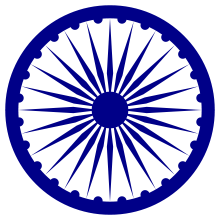Chang dance
Chang dance (Hindi: चंग नृत्य) is a folk dance from Rajasthan, India. It is also referred to Dhamal,[1][2] dhuff dance,, and as Holi dance as it is performed during the Hindu festival of the same name (Holi) to celebrate the defeat of evil.[3] It is a group dance performed by men, carousing and singing riotously to the rhythmic beat of the chang instrument.[4]
| Part of a series on the |
| Culture of India |
|---|
 |
| History |
| People |
|
Mythology and folklore |
| Cuisine |
| Religion |
|
|
Music and performing arts |
| Sport |
|
Monuments |
|
It originates from the Shekhawati region of Rajasthan.[5][6] This dance period is starts from the Maha Shivaratri festival and ends on Dhulandi, which is the day after the Holi festival. Folk songs used in this folk dance are called Dhamaal.[7][8] All men sings, dance and dance. Meanwhile, some represents also plays which is called Sang.
Instruments
- Chang, or, duff (a kind of tambourine) - Eponymous with the folk dance form, this instrument consists of a wooden disc, typically 2 feet (24 in) to 3 feet (36 in) in radius, covered on a single side with stretched male sheep skin leather.[9] The turmeric and other aromatic sprays are made on. Some type of painting is also made on it.
- Cymbal - round flat or convexity metal (usually bronze or iron) rhythm instrument, the couple is played by onto the rag date.
- Flute - it is created from natural bamboo. Bales is removed inside Bamboo, eight holes on the body are made. First holes of all are to play with the mouth, the rest seven gives different sounds out of the hole.
- Ghungroo - a musical anklet tied to the feet of classical Indian dancers
- Drums and other instruments are currently in use also.
The time of chang dance
Chang dance starts from Mahashivratri (a festival of India) during day and night whole the month and ends at last of Holi festival. People after agriculture and domestic work collects in Chauk (a ground in the village) and enjoys it.
Area of chang dance
Chang dance event is all over Rajasthan. But this major area shekhawati region (sikar, churu, jhunjhunu and Bikaner) where this dance is much disciplined, systematic way with sponsored scheme. This dance is usually in the border districts States of Rajasthan are found.
References
- Menon, Anasuya (24 April 2013). "Spirited dance, pulsating music". The Hindu. Retrieved 7 April 2015.
- "Haryana Fest Today". The New Indian Express. Kochi. Express Features. 23 April 2013. Retrieved 7 April 2015.
- "Prince Charles dances in India at Holi celebration". BBC News. 5 October 2010. Retrieved 7 April 2015.
- Mathur, U. B. (2002). Treasure-trove of Rajasthan. Folklorists. p. 167. ISBN 978-81-85129-01-3.
- Sharma, B. K.; Kulshreshtha, Seema; Rahmani, Asad R. (14 September 2013). Faunal Heritage of Rajasthan, India: General Background and Ecology of Vertebrates. Springer Science & Business Media. p. 30. ISBN 978-1-4614-0800-0. Retrieved 1 April 2015.
- Bhatia, Ritika (18 October 2014). "Jodhpur RIFF 2014: Dance of the dunes". Business Standard. Retrieved 7 April 2015.
- "Dhamaal - Traditional Music of Shekhawati". Underscore Records. Retrieved 9 April 2015.
- "Culture and Heritage". shekhawati.in. Indian Heritage Cities Network. Archived from the original on 13 April 2015. Retrieved 10 April 2015.
- Goyal, Vipin Behari (1 October 1997). Tirthraj Pushkar: Insight into rural life in Rajasthan. p. 22. ISBN 978-93-5126-292-3.